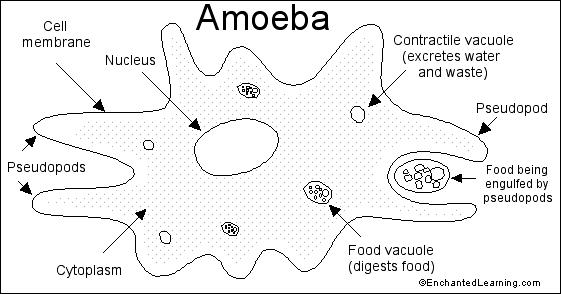
 |
| You might also like: | Label Amoeba | Amoeba (Ameba) Read-and-Answer Quiz | Bacteria | Label the Bacterium Cell | Plant and Animal Cells Venn Diagram | Today's featured page: Australian Animal Printouts |
| Our subscribers' grade-level estimate for this page: 5th - 6th |
| Go to an Amoeba Quiz Amoeba Label Me! Printout | EnchantedLearning.com Amoeba (Ameba) | Animal Printouts Label Me! Printouts |


Click on a region in the picture to color it in with the selected color.
Click on a color swatch in the palette to select a new color.
The currently selected color in the palette is indicated by a black rectangle drawn around it.
When you click, the point that you're clicking on is at the tip of the arrow or the tip of the pointing finger.
The amoeba is a tiny, one-celled organism. You need a microscope to see most amoebas - the largest are only about 1 mm across. Amoebas live in fresh water (like puddles and ponds), in salt water, in wet soil, and in animals (including people). There are many different types of amoebas. The name amoeba comes from the Greek word amoibe, which means change. (Amoeba is sometimes spelled ameba.)
Anatomy: An amoeba consists of a single blobby cell surrounded by a porous cell membrane. The amoeba "breathes" using this membrane - oxygen gas from the water passes in to the amoeba through the cell membrane and carbon dioxide gas leaves through it. A complex, jelly-like series of folded membranes called cytoplasm fills most of the cell. A large, disk-shaped nucleus within the amoeba controls the growth and reproduction of the amoeba.
Diet: Amoebas eat algae, bacteria, plant cells, and microscopic protozoa and metazoa - some amoebas are parasites. They eat by surrounding tiny particles of food with pseudopods, forming a bubble-like food vacuole. The food vacuole digests the food. Wastes and excess water are transported outside the cell by contractile vacuoles.
Locomotion: Amoebas move by changing the shape of their body, forming pseudopods (temporary foot-like structures). The word pseudopod means "false foot."
Reproduction: Amoebas reproduce asexually by binary fission. A parent cell divides (the nucleus also divides in a process called fission) and produces two smaller copies of itself.
Classification: Eukaryota (organisms with nucleated cells), Kingdom Protista (flagellates, amoebae, algae, and parasitic protists), Phylum Protozoa (single-celled organisms), Class Sarcodina (having pseudopods).
Copyright ©2001-2018 EnchantedLearning.com ------ How to cite a web page